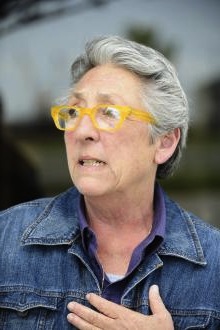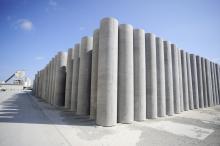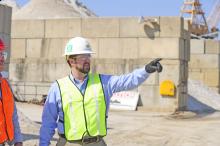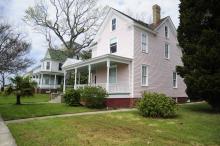Inside Business Report Focuses on Bayshore Concrete

Cape Charles Police Chief Charles “Sambo” Brown

Mayor Sullivan (photos by Harry Gerwien, Inside Business)
EDITOR’S NOTE: From time to time, newspapers and magazines record their impressions of our fair village.
The reports invariably are of interest to local residents, even if they already know everything they read.
Last May, the Hampton Roads business journal Inside Business sent reporter Bill Cresenzo and photographer Harry Gerwien across the Bay to take a measure of Cape Charles. They took a look, and saw Bayshore Concrete Products. Inside Business has graciously permitted the Wave to reprint the entire interesting story below.
CAPE CHARLES HAS A WAY OF STAYING ALIVE
By BILL CRESENZO
Inside Business
May 11, 2012
Dora Sullivan and Charles Brown are sitting in chairs on the sidewalk in the heart of Cape Charles on a recent sunny spring day.
The strip of commercial space that lines the town’s main street is quaint and historic, with a hardware store, a pub, a boutique hotel that just reopened and a couple of souvenir shops.
All are within walking distance of Cape Charles Beach, a well-kept stretch of sand that features a fishing pier that extends into the Chesapeake Bay — no fishing license required, compliments of the town.
Sullivan and Brown are quick to say hello to a couple of passers-by and introduce themselves.
Sullivan informs them that she is originally from Egypt.
Fifteen years ago, she and her husband, Michael, happened by the small town at the southern end of the Eastern Shore, while living in Virginia Beach. They decided they just had to live in Cape Charles.
Now “I’m the mayor,” Sullivan said.
She waved her hand at Brown.
“And this is our police chief.”
Across the harbor in view of where Sullivan and Brown sit is Bayshore Concrete Products with its cranes, its 86 rocky acres and concrete segments pointing to the sky, waiting to be shipped up the East Coast.
It’s a scene that one wouldn’t necessarily call pretty.
But in the eyes of Sullivan and Brown, who worked at Bayshore Concrete before becoming police chief, and of the residents of Cape Charles who depend on the company to keep the town’s economy alive, Bayshore Concrete — one of Northampton County’s largest employers — is a classic case of beauty being in the eye of the beholder.
“It is a most beautiful thing to look at,” Sullivan said, “because it creates jobs.”
CONTINUED FROM FIRST PAGE
Cape Charles is at a crossroads. Its population is in decline. The nearest local hospital — and Northampton County’s largest employer — is moving to another county. Bayshore recently missed out on an opportunity to provide the concrete for major transportation projects in Hampton Roads and, at least for now, supplying the concrete for a proposed wind farm off of its coast.
But the people who live there, including Brown and Sullivan, are friendly, hardy and optimistic, as they have always been.
When it was chartered in 1885, Cape Charles, about an hour from Norfolk, was a railroad town. The first train arrived in the area in 1884, and soon after the town thrived. By the early 1900s, according to the town’s history, more than 300 railcars per day came through.
The railroad age ended after World War II, and the town experienced a steep decline.

Bayshore concrete segments point to the sky.
But its fortunes changed in the late 1950s when it was announced that one of the great wonders of the engineering world — the Chesapeake Bay Bridge-Tunnel – -would be built, connecting the Eastern Shore to mainland Virginia.
The Peninsula Enterprise newspaper announced in October 1958 that a new concrete plant in Cape Charles would provide the project’s infrastructure and create 400 new jobs. Three companies came together to form the new concrete company — Tidewater Construction Corp., Raymond International and Peter Kiewitt & Sons.
The town again experienced a boom. But once construction on the bridge-tunnel project was completed, the town continued to slide — ironically, the new bridge and tunnel contributed to this, because trucks began taking the place of railroad deliveries.
Still, the concrete company remained, and Skanska, one of the largest contractors in the world, with $19 billion in revenue, ultimately bought it.
Bayshore, which at its peak had 400 employees, now has about 150 workers.
“We are smaller now, due to the competitive nature of the construction business,” said Chad Saunders, Bayshore’s general manager.
The company has been through several up and down cycles. Its peak was in 1995, when the parallel span to the Chesapeake Bay Bridge was built.
The company’s primary customers are in North Carolina and states to the north, particularly because the labor rates are cheaper in Cape Charles and get more expensive up the East Coast. The concrete is mostly used for various transportation projects — bridges, marinas and tunnels.
Today, Bayshore produces up to 100,000 cubic yards of concrete each year, enough concrete to build 42 miles of interstate highway or a sidewalk 511 miles long.
The company relies on sand, gravel, cement and water to make its products, and the people who produce it are the salt of the earth.
“Almost everyone who works here lives here,” Saunders said.
Wayne Bell has spent the past 38 years working for Bayshore. He was 21 years old the first day he started there. He had spent three years at Howard University, but with a wife and a child on the way, he decided to forgo a degree for work.
“I was scared to death,” he said. “I didn’t know nothing.”
More than three decades later, he has worked as a laborer, a technician, a steel tier, and now, an assistant plant manager.
Most of the workers have been at the plant for 15 or 20 years. Saunders said he doesn’t know how difficult it will be to find new workers as the older ones age into retirement.
It’s hard, back-breaking work that can take its toll.
“It’s the hottest place in the summer and the coldest place in the winter that you can be,” said Chip Watson, who has owned the town’s hardware store for decades. Watson himself wanted to work at Bayshore, but his mother wouldn’t let him.
“She said, ‘I’m not going to have my child around concrete poles that might fall on him,'” he recalled.
LOST OPPORTUNITIES?

Chad Saunders is Bayshore’s general manager.
Last year, Old Dominion University economist James Koch wrote about Bayshore in his “State of the Region” report. Titled “The Concrete Connection: Economic Growth For Virginia’s Eastern Shore,” Koch said that the midtown and downtown tunnel project in Norfolk, as well as the proposed “Patriots Crossing,” could prove to be an economic boom for the Cape Charles, if the concrete used for the projects were made at Bayshore.
But the harbor at Bayshore isn’t deep enough to transport the huge concrete cylinders that will make up the new tunnels. The cylinders would weigh up to 15,000 tons and stand 29 feet tall.
Skanska, which formed a company with Macquarie Financial Holdings, called Elizabeth River Crossings LLC, to work on the tunnel projects, is producing the cylinders in Baltimore, not Cape Charles.
Now, Bayshore has turned its eye toward wind farms.
In his report, Koch said:
“Bayshore would have to be a leading candidate to produce, move and install giant precast concrete tunnel segments of four proposed bridge and tunnel projects in Hampton Roads and also the approximately 160 large concrete foundations for the wind farm turbines out in the Atlantic Ocean. The problem is that the existing Cape Charles Federal Harbor/Federal Channel is not capable of handling these huge objects.”
The harbor’s channel is 18 feet deep and would have to be dredged to about 35 feet, which would cost up to $3.5 million. Koch said that the economic benefit of the project would be $1.925 billion for the commonwealth, which would decline to $637 million if a non-Virginia-based firm produces the concrete.
Last week, Gamesa Energy USA and Huntington Ingalls Newport News Shipbuilding announced that they have stopped plans to build a wind turbine prototype off of Cape Charles because the fledgling wind energy market in the U.S. isn’t strong enough to support the risks that the project would bring.
“Their decision should not directly impact any other projects,” said Jeff Caldwell, spokesman for Gov. Bob McDonnell. “It was their own business decision.”
A SHRINKING POPULATION

The town has beautiful Victorian and Colonial homes.
Northampton County, considered the second poorest county in Virginia, has a median family income of just $28,276.
And when Sullivan moved to town 15 years ago, Cape Charles had 1,800 residents.
Now, it has 1,009.
But there is another side to the numbers: Cape Charles’ place as a summer haven for the rich who have homes along its waters.
In the 15 years since she has been in Cape Charles, Sullivan said, the town’s part-time population has tripled. About 860 are part-time residents.
In 1992, Cape Charles annexed 2,191 acres of land from Northampton County, owned by Brown and Root and by Bayshore.
In 1998, the Brown and Root property was sold to Baymark Construction, whose president, Richard “Dickie” Foster, helped build the Chesapeake Bay Bridge- Tunnel when he was 17.
Decades later, he built Bay Creek, a huge, gated high-end development with a country club and golf course. Home prices go into the millions.
While Sullivan welcomes the part-time residents — after all, they pay property taxes — they don’t take the place of the full-timers.
“They can’t support local businesses,” she said. “They don’t buy pizza and make copies every week.”
Cape Charles also has a thriving tourism industry. Developer David Gammino of City & Guilds in Richmond has gutted the building that was the historic Cape Charles Hotel and renovated it into a high-end, boutique hotel.
At 15,000 square feet, the hotel has 16 rooms and retail space.
Before Gammino bought it, the hotel was open for five years until it went into foreclosure and sat vacant for two years. Then Gammino, who vacations on Cape Charles, stepped in to purchase it.
“I feel very optimistic about Cape Charles,” Gammino said. “The infrastructure is there by virtue of the Bay Creek Development. These are beautiful facilities and when you look at the town itself, it’s a beautiful, historical town. When I look at those components, it is very well positioned to grow.”
LOOKING TOWARD THE FUTURE
Mayor Sullivan envisions Cape Charles as a “place to live, for any age group, because of the quality of life.”
But there are things that worry the mayor, namely that the local hospital, Riverside Shore Memorial, plans a move that would take it 40 miles away from Cape Charles.
The hospital said that it needs to expand and “renovation of our current facility would be prohibitively expensive and would significantly disturb patient care for an extended period.”
The factors involved in the decision-making process included demographics — age, population distribution, employers, physician issues, and growth trends, the hospital said.
“All of a sudden we have gone from a town that has everything to offer to not having the most important thing that should be a given — health care,” Sullivan said.
When the conversation turns back to Bayshore, she says:
“We absolutely have to keep Bayshore. We are such good neighbors. I can’t imagine them not being here. They are very good to this town.”
The above story was reprinted by permission from Inside Business. It may be read at the Inside Business website here: http://insidebiz.com/news/cape-charles-has-way-staying-alive




















Great article! It makes a good case for dredging the harbor to 35 feet. That will help Bayshore, Hinckley and the town. Now how can we get the Army Corps of Engineers to do the work with some of that Obama stimulus money?
Sir, the Obama “stimulus” money is LONG gone — spent on cronyism, campaign supporter kickbacks and producing $1 of revenue for America at a cost of $5.60 per dollar returned. Dear Lord, DO NOT get the Feds involved.
How about this one: Move ALL town offices OFF of the main commercial boulevard, use the school for all municipal government offices and a community center and SELL THE COMMERCIAL DISTRICT property for its highest and best use!
But as long as the town government — for example, after someone purchases a vacant building that sat empty for two years, and then puts millions into making it habitable and rentable — pesters them to DEATH over something as earth-shattering as PATIO DIVIDERS — the town will suffer.
I’m 300 miles away reading about the overarching town government — do you think that investors are NOT?